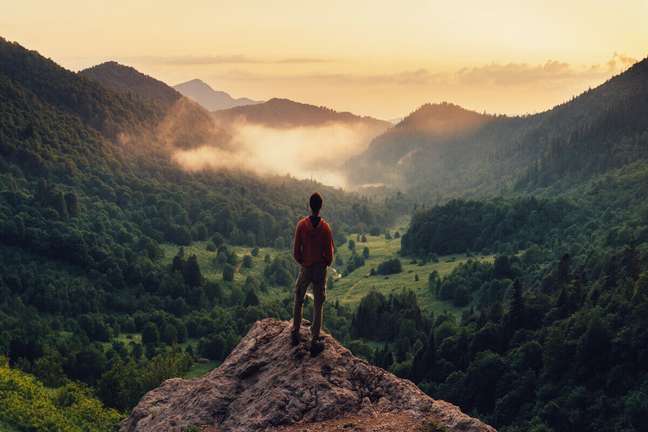Sensing and feeling the natural connections that sustain life on Earth helps restore the enchantment to the world.
Once, silently, on a path through a dense forest in the Serra da Mantiqueira, I passed by a tree and immediately felt a deep sadness. I looked at her and, without thinking, said that there was something wrong with that being. My walking partner was surprised and asked me to speed up my pace. We had little time before dark. A few minutes later, still nearby, we heard a crash in the woods. It was her, I thought. The tree. I ran back and then my eyes only saw what the heart already felt. The tree on the ground.

Sometimes, through inattention or convenience, we forget that we are part of nature. And that what happens to her affects us, somehow, at a certain point. In different, unexpected, and even inexplicable ways, we are constantly connected to the great web of the natural world. Because even when the melody is not conscious or when it seems not to exist, it does not cease to exist. One way or another.
Opening new eyes to this relationship can reveal powerful discoveries about how nature works. This includes realizing more not only about the climate, animals, plants, rivers and mountains, but also about ourselves and our urgency to restore harmony to this interaction. And there are many ways to do this beautiful journey of reconnection.
The relationship of man with nature
German forest writer and engineer Peter Wohlleben suggests something interesting in the book The secret wisdom of nature (publisher Sextante), released this year in these parts. His idea is that knowing curious stories about the fantastic ecosystem relationships involving different beings and natural phenomena generates more effects on us than listening to impersonal speeches and purely technical explanations.
Over decades of observing nature and leading groups on woodland walks, she has learned firsthand that it is more important that visitors understand her comments on an emotional level. “Only in this way can I guide them on a complete sensory walk through nature, because this is how I communicate the most important part: the joy that all creatures and their secrets can offer us,” she writes.
Therefore, the book is a collection of scientific evidence on this exuberant (perhaps not so secret) wisdom of nature, written smoothly, with enthusiasm, but also with a warning about the limits of our actions on this subtle mechanism. Peter tells, for example, how the extermination of wolves in Yellowstone National Park, USA, in the 1920s, ended up altering the course of a river – so many were the cascading effects that occurred from the alteration of a single element of that ecosystem.

What does the dynamism of nature teach men?
In this complex web of interconnected relationships, we learn that balance is dynamic. To maintain it, nature is always in motion, fine-tuning each piece with highly organized, refined arrangements that are ultimately unpredictable. And, while they’re also invisible to us, it’s these interactions between rivers and animals, between forests and rainfall that maintain the delicate and complex workings of nature — at least until humans drastically impact this orchestra. Really?
“When humans started wanting to control nature, we apparently saw this control. But even so, nature remains the same, functioning in a very dynamic and unpredictable way, continuously transforming itself,” says biologist and nature educator Rita Mendonça, founder of the Romã Institute of education and experiences with nature and teacher at the Escola Schumacher Brasil.
Basically, what Peter’s stories reveal is that this wisdom of nature it is far beyond our ability to control it. Did you know that sandstorms from the Sahara desert cross the Atlantic Ocean every year and fertilize the soil ravaged by fires in the Amazon region? Is not it fantastic?
Understanding nature means engaging with life
There is a lot to be happy about on our planet. Want another example? Take a look at the relationship between salmon and trees, also described in the book: Studies show that tree growth can depend almost entirely on these fish, especially in regions with less fertile soil. Why does this happen? Why salmon and how they are eaten by bears (which leave their remains in the water, on rocks and on river banks) ultimately play an important role in the distribution of nutrients to the soil where trees grow – or not – .
This dynamic, if it were a fairy tale, would have even more characters and storylines, from mushrooms and fallen leaves to rotting logs and an army of organisms cleaning and making way for the elixirs of life to be absorbed through the earth and roots. But how can we understand all this? Educator Rita Mendonça says that knowledge breeds reverence and reverence breeds more desire for knowledge. And here’s an important detail:
“Everyone produces knowledge in every moment, based on their own experiences. knowledge that comes from abstract logic makes us disengaged from the living world. To confront life, with nature, we need to look, listen, smell, taste, pay attention, observe, develop our intuition”, she comments. The philosopher Heráclito, says Rita, stated that “nature loves to hide”. “Goethe already says that there is no secret, nature has no veil, it is completely exposed to us, but we must look with eyes that see this splendour”.
Text originally published in Vida Simples Magazine (Edition 248).
Edited by Giuliana Capello
Journalist and ecofeminist. She considers herself a deep worshiper of every detail of nature.
+The best content in your email for free. Choose your favorite Terra newsletter. Click here!
Source: Terra
Ben Stock is a lifestyle journalist and author at Gossipify. He writes about topics such as health, wellness, travel, food and home decor. He provides practical advice and inspiration to improve well-being, keeps readers up to date with latest lifestyle news and trends, known for his engaging writing style, in-depth analysis and unique perspectives.







